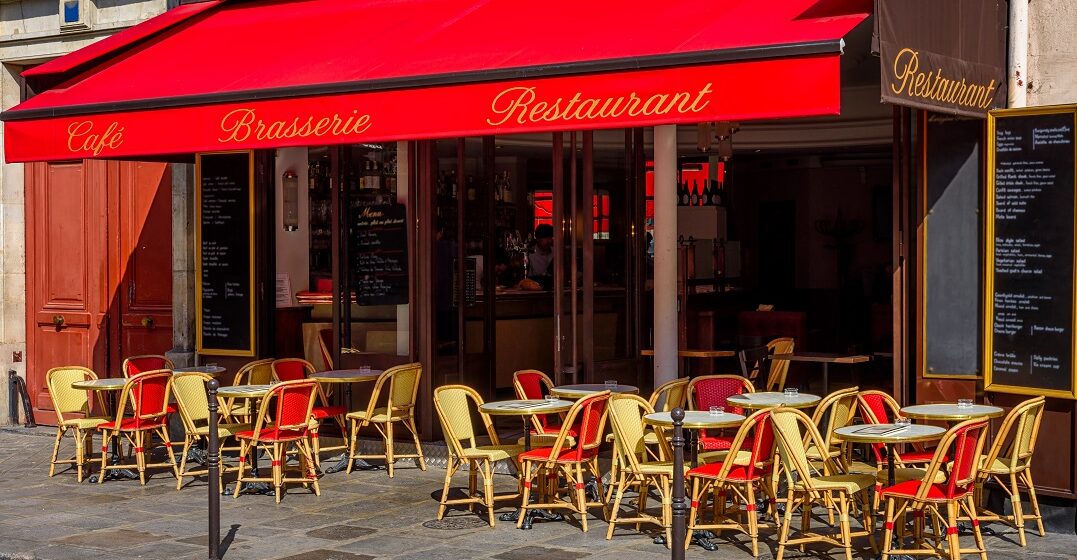Updated on January 3, 2024

French brasserie, bistro or restaurant: What’s the difference?

Would you like to order your first meal in a French restaurant and get a taste of local and national dishes? Of course, if you’ve just started to study French, you’ll have to learn some basic food vocabulary. But you’ll also have to consider a few cultural aspects, including what type of venues will best cater to your needs. How do you differentiate between a French brasserie, a bistro, a restaurant or even a café? To answer this we need to consider several factors, including opening times, the type of food and drinks served, the average price range and the overall setting and decor.
The first meaning of une brasserie is “brewery”. But don’t be fooled: Far from serving only beers and other alcohol, French brasseries also serve up delicious food. They tend to offer very traditional French dishes, with classics like un steak tartare, un coq au vin or une choucroute garnie (sauerkraut with cold meats). Brasseries are open throughout the day, from morning until late at night. Because they became popular across Paris in the 19th century, you can expect to find high ceilings, leather banquettes and oversized mirrors inside. Nowadays, they continue to display a noisy and bustling atmosphere, and a quick service, which makes it perfect if you’re in a bit of a rush.
According to some, the term bistro, which is sometimes spelled bistrot, comes from the Russian word быстро, which means “quick”. After the Napoleonic wars, Russian soldiers who occupied Paris would shout the word at waiters in order to speed things up. Whether true or not, this is emblematic of the quick service bistros are known for. A typical bistro is a small, casual venue, offering low prices and traditional, home-style dishes like une soupe à l’oignon (onion soup) or un cassoulet. Their menu is traditionally more limited than in brasseries. Bistros also tend to open only for lunch and dinner, and not in between.
The word restaurant is by far the most generic in our list and encompasses a large variety of establishments. They can feature all types of food, prices and settings. Of course, you’ll find many restaurants offering French meals, be it traditional dishes or nouvelle cuisine. But, in large cities, you’ll also be able to opt for cuisines from around the world.
Like bistros, restaurants in France are open at specific hours for lunch and dinner but are closed in the morning and in the afternoon. Generally speaking, they offer a more refined service and menu than in brasseries and bistros. As such, it’s more common to book a table in a restaurant to celebrate a special event with your family or for a romantic dinner.
Faced with the large variety of venues available, you can rely on official restaurant guides to make an enlightened choice. By far, the most famous and most revered one is le Guide Michelin, also known as le Guide rouge (red guide) due to the color of its cover. Its yearly attribution of stars is like the Oscar nights of the gastronomic world.
As you may expect, French cafés are more focused on drinks than food. Their menus include a variety of coffees and hot and cold beverages. But you’ll also be able to order some snacks, like pastries, salads, sandwiches and croque-monsieur. Like brasseries, cafés are open throughout the day, from breakfast time until late in the evening.
Cafés are also very much a part of social life in France. They are convivial places to chat with friends, read the paper or watch the world go by. When the weather allows it, cafés may have outside areas on a city square where you can linger in the sunshine. They can even be a place for more in-depth debates if you choose to go to un café philosophique (a philosophy café).
French food and cuisine are renowned throughout the world, and there are many venues where to enjoy the variety of dishes, at different prices, times and settings. French brasseries and bistros tend to offer more traditional and affordable meals, with fairly speedy service and noisy atmosphere, while restaurants are usually better for more special fares. Meanwhile, cafés are more focused on drinks and having a relaxing time. Now, take your newfound knowledge and explore all that the French culinary scene has to offer!